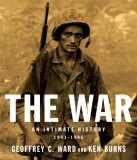Who-o-o's Scared? I'm Not Scared! by Jonathan Allen
 It's nothing new when little ones are a bit afraid of the dark, but what if you're a little owl and it's your job to go out at night?
It's nothing new when little ones are a bit afraid of the dark, but what if you're a little owl and it's your job to go out at night?
In Jonathan Allen's I'm Not Scared! Baby Owl, clutching his plush lovey Owly, sets out for a walk in the darkling woods. "I am NOT scared!" he tells Owly. "And I should be out in the woods at night. It's what owls do!"
Still, the woods ARE spooky, dark, and deep, and Baby Owl's eyes grow bigger and rounder as he stumbles through the trees, rendered in deep blues, purples, and black. Suddenly he bumps into Badger, who apologizes for frightening him. "I'm NOT scared," Baby Owl insists, and resolutely continues his stroll. In turn he meets up with Bear, big and black in the night, and Bat, who tries to atone for startling Baby Owl.
At last the tension is just too much for Baby Owl. He plops down with his little yellow feet sticking straight up and protests (too much, methinks) that HE'S NOT SCARED! At this point Papa Owl appears to scoop up the little one and reassuringly carries him home to tuck him in. After all, with dawn about to break, it is the proper bedtime for little owls.
"It's OK to be a little scared of the dark," whispers Papa.
"Papa means YOU, Owly," Baby Owl murmurs sleepily.
Allen's illustrations get the maximum emotion out of Baby Owl's little face, and his nighttime landscape is dark but not too scary as he meets other friendly nocturnal creatures out and about. The endpapers are a real hoot, with pictures of Baby Owl's varied emotions as he deals with his fears. Kids who are overcoming their fear of the dark will appreciate the situation of Baby Owl, who knows he has to face the scene when the sun goes down.
I'm Not Scared is the sequel of Allen's 2006 I'm Not Cute!
Labels: Bedtime Stories, Owl Stories (Ages 2-5)


























